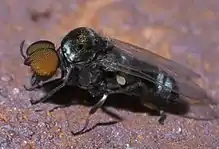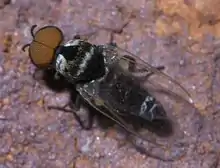| Simulium | |
|---|---|
.png.webp) | |
| Simulium trifasciatum | |
| Scientific classification | |
| Domain: | Eukaryota |
| Kingdom: | Animalia |
| Phylum: | Arthropoda |
| Class: | Insecta |
| Order: | Diptera |
| Family: | Simuliidae |
| Tribe: | Simuliini |
| Genus: | Simulium Latreille, 1802 |
| Type species | |
| S. colombaschense | |
| Subgenera | |
|
See Text. | |
| Synonyms | |


Simulium is a genus of black flies, which may transmit diseases such as onchocerciasis (river blindness).
It is a large genus with almost 2,000 species and 38 subgenera.[1]
The flies are pool feeders. Their saliva, which contains anticoagulants, a number of enzymes and histamine, is mixed with the blood, preventing clotting until it is ingested by the fly. These bites cause localized tissue damage, and if the number of feeding flies is sufficient, their feeding may produce a blood-loss anaemia.
The host's reaction to fly attacks may include systemic illness, allergic reactions or even death, presumably mediated by histamine. In humans, this systemic reaction is known as "black fly fever" and is characterized by headaches, fever, nausea, adenitis, generalized dermatitis, and allergic asthma.
Systematics
Subgenera:
- Afrosimulium Crosskey, 1969
- Anasolen Enderlein, 1930
- Asiosimulium Takaoka & Choochote, 2005
- Aspathia Enderlein, 1935
- Boophthora Enderlein, 1921
- Boreosimulium Rubtsov & Yankovsky, 1982
- Byssodon Enderlein, 1925
- Chirostilbia Enderlein, 1921
- Crosskeyellum Grenier & Bailly-Choumara, 1970
- Daviesellum Takaoka & Adler, 1997
- Ectemnaspis Enderlein, 1934
- Edwardsellum Enderlein, 1921
- Eusimulium Roubaud, 1906
- Freemanellum Crosskey, 1969
- Gomphostilbia Enderlein, 1921
- Hebridosimulium Grenier & Rageau, 1961
- Hellichiella Rivosecchi & Cardinali, 1975
- Hemicnetha Enderlein, 1934
- Inaequalium Coscarón & Wygodzinsky, 1984
- Inseliellum Rubtsov, 1974
- Lewisellum Crosskey, 1969
- Meilloniellum Rubtsov, 1962
- Metomphalus Enderlein, 1935
- Montisimulium Rubtsov, 1974
- Morops Enderlein, 1930
- Nevermannia Enderlein, 1921
- Notolepria Enderlein, 1930
- Obuchovia Rubtsov, 1947
- Phoretomyia Crosskey, 1969
- Pomeroyellum Rubtsov, 1962
- Psaroniocompsa Enderlein, 1934
- Psilopelmia Enderlein, 1934
- Psilozia Enderlein, 1936
- Pternaspatha Enderlein, 1930
- Rubzovia Petrova, 1983
- Schoenbaueria Enderlein, 1921
- Simulium Latreille, 1802
- Trichodagmia Enderlein, 1934[2]
- Wallacellum Takaoka, 1983
- Wilhelmia Enderlein, 1921
- Xenosimulium Crosskey, 1969
Species:
In Balkan folklore
In Serbian mythology there is a legend concerning an ala (demon) (a female entity associated with hailstorms, madness and disease) fabled to have died in a cave near the town of Golubac in the Pozarevac District in Eastern Serbia. The rotting corpse of this being is said to send forth each Spring a swarm of Golubatz flies – individuals of the species Simulium colombaschense. The fact that the Golubatz fly is a voracious bloodsucker and disease vector accords well with the functions attributed to the ala, emphasising her malign potency – even in death – while the legend provides, reciprocally, a folkloric explanation for the genesis of so unpleasant an insect.[3][4] The specific name colombaschense signifies 'of Golubac' (Serbian pronunciation: 'Golubatz') – the name of the village (signifying dovecote from Slavic golub a dove/pigeon (see Columbidae), cognate with Latin: columba, having the same meaning). S. colombaschense was a notorious insect pest of the Banat (part of the Pannonian Basin, bordered to the south by the Danube), during the 18th century.[5]
References
- ↑ Peter H. Adler (2022). "World Blackflies (Diptera: Simuliidae): A Comprehensive Revision of the Taxonomic and Geographical Inventory" (PDF). South Carolina: Clemson University. p. 145.
- ↑ Hernandez Triana, Luis M. (2011). Systematics of the Blackfly Subgenus Trichodagmia Enderlein (Diptera: Simuliidae: Simulium) in the New World. Wageningen University. pp. ix, 1–536. ISBN 9789085858652.
- ↑ Ramel, Gordon John Larkman (4 March 2007). "The Nematocera". Earth-Life Web Productions. Archived from the original on 6 August 2007. Retrieved 2007-08-21. (Beside biological data, the page mentions a legend on black flies from the Carpathians.)
- ↑ Karadžić, Vuk Stefanović (2005). Живот и обичаји народа српскога (in Serbian). Belgrade: Politika : Narodna knjiga. p. 276. ISBN 86-331-1946-3.
- ↑ Thompson, F. Christian (March 2001). "The Name of the Type Species of Simulium (Diptera: Simuliidae): an historical footnote". Entomological News 112 (2): 125. Retrieved 2011-04-08.
Bibliography
- Crosskey R. W. ; The natural history of blackflies. Willey, New York, 1990. ISBN 0-471-92755-4
- Honomichl K. ; Bellmann, H. ; Biologie und Ökologie der Insekten. CD-Rom. Gustav Fischer, Stuttgart, 1994. ISBN 0271004177
- Jedlicka, L.; Stloukalova V. ; Family Simuliidae. pp. 331–347 in: Papp, L. and Darvas, B. (eds.): Contributions to a Manual of Palaearctic Diptera, Volume 2. Science Herald, Budapest, 1997.
- Jensen, F. ; Diptera Simuliidae, Blackflies. pp. 209–241 in: Nilsson, A.N. (ed.): Aquatic Insects of North Europe. A Taxonomic Handbook. Apollo Books, Stenstrup, 1997.
- Kim, K. C. ; Merritt, R. W. (Eds.) ; Black flies, ecology, population management, and annotat. world list. University Park, London, 1987. ISBN 0-271-00417-7
- Laird, M. (Ed.) ; Blackflies. Academic Press, London, 1981. ISBN 0124340601
- Lechthaler, W. ; Car, M. ; Simuliidae − Key to Larvae and Pupae from Central− and Western Europe. Vienna 2005, ISBN 3-9501839-3-0
- Seitz, G. ; Verbreitung und Ökologie der Kriebelmücken (Diptera: Simuliidae) in Niederbayern. in: Lauterbornia. Mauch, Dinkelscherben 11.1992, pp. 1–230.
- Timm, T. ; Dormanzformen bei Kriebelmücken unter besonderer Berücksichtigung des Ei-Stadiums (Diptera: Simuliidae). in: Entomologia generalis. Schweizerbart, Stuttgart 12.1987, 133-142. ISSN 0340-2266
- Timm, T. ; Unterschiede in Habitatselektion und Eibiologie bei sympatrischen Kriebelmückenarten (Diptera, Simuliidae). in: Mitteilungen der Deutschen Gesellschaft für Allgemeine und Angewandte Entomologie. Bremen 6.1988, 156-158. ISSN 0344-9084
- Timm, T. ; Rühm, W. (Hrsg.) ; Beiträge zur Taxonomie, Faunistik und Ökologie der Kriebelmücken in Mitteleuropa. Essener Ökologische Schriften. Bd.2. Westarp Wissenschaften, Magdeburg 1993. ISBN 3-89432-078-8
- Wichard, W. ; Arens, W. ; Eisenbeis, G. ; Atlas zur Biologie der Wasserinsekten. Stuttgart, 1994. ISBN 3-437-30743-6
- Wirtz, H. P. ; Analyse der Histaminanteile im Speichel verschiedener Kriebelmückenarten (Diptera: Simuliidae). in: Mitteilungen der Deutschen Gesellschaft für Allgemeine und Angewandte Entomologie. Bremen 6.1988, 441-442. ISSN 0344-9084